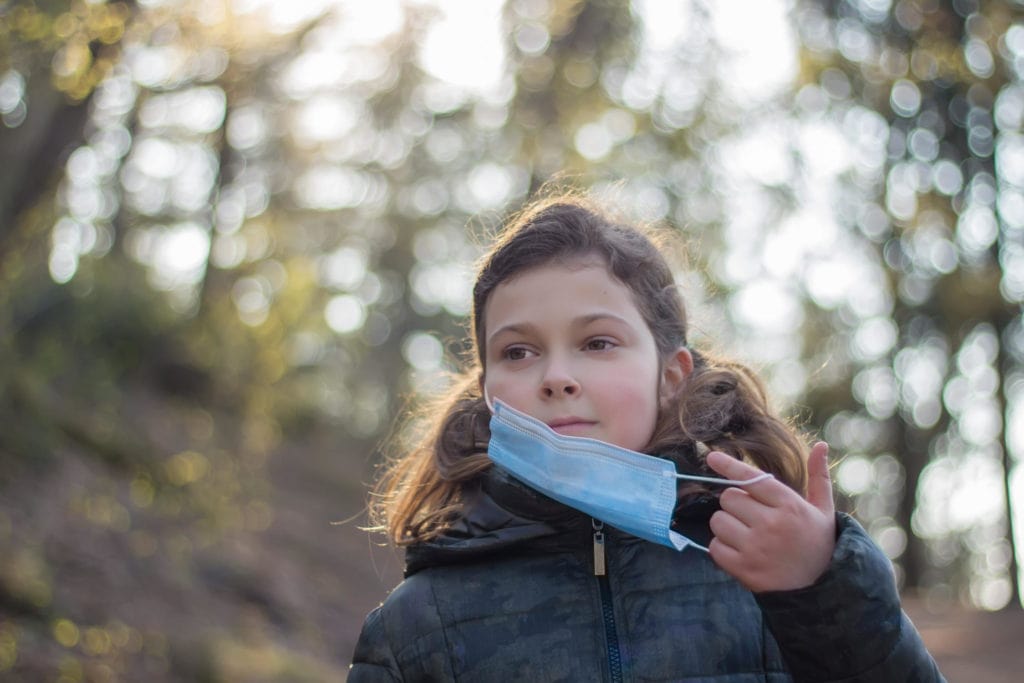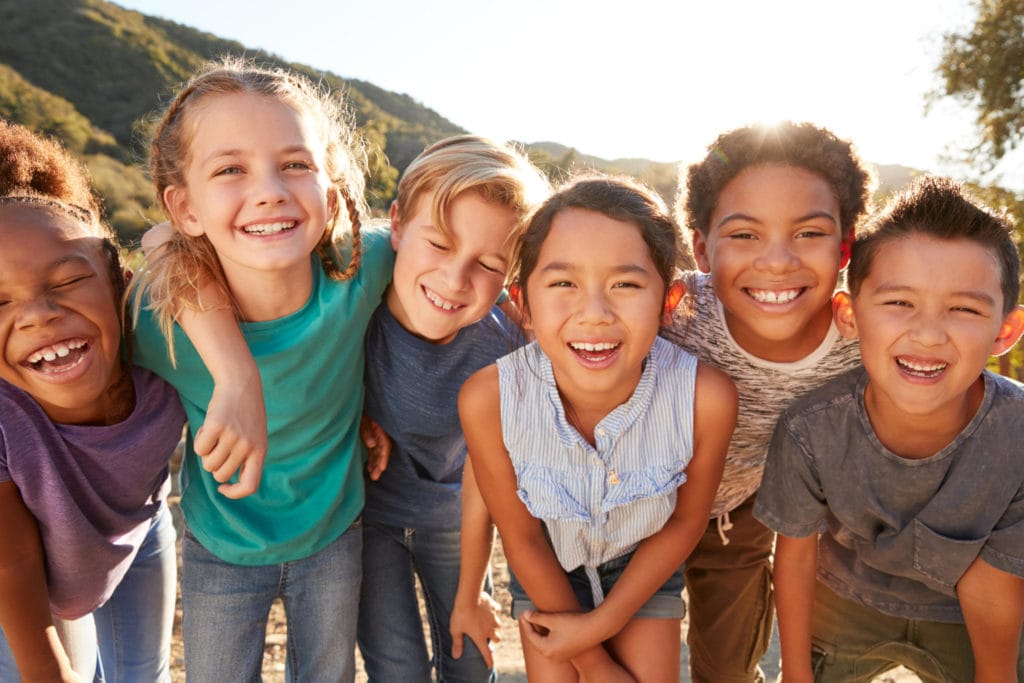
Face masks for children were introduced around the world at various points during 2020 using the comforting slogan, ‘I protect you. You protect me,’ along with assurances that masks would only be temporary – to flatten the curve.
Today in many schools, masks for children continue to be uniformly mandated despite evidence that suggests that their risks outweigh any potential benefits for children.
Key risks to masks for children
- Breathing problems – hypoxia (inadequate oxygen) and hypercapnia (elevated carbon dioxide levels in the blood): Normal open air has approximately 0.04% carbon dioxide by volume (400 parts per million) and the German Federal Environmental Office states that the limit for closed rooms is 0.2% (2,000 ppm), with anything higher being unacceptable. However, evidence shows that carbon dioxide levels inside children’s masks build up very quickly. After as little as three minutes, carbon dioxide in children’s masks have been measured to be in the region of 13,000 ppm, more than six times the maximum carbon dioxide exposure. Younger children tend to have the highest values. Significantly lowered levels of oxygen have also been found in the air under masks. These levels are associated with conditions including headaches, drowsiness, poor concentration, nausea and increased heart rate.
- Bacterial, viral and fungal infections such as bacterial pneumonia: Studies have found that germs (bacteria, fungi and viruses) accumulate on the outside and inside of the masks, in a warm and moist environment. Inhaling these germs can cause fungal, bacterial and viral infections.
- Cognitive difficulties: Wearing of masks is associated with problems such as fatigue, exhaustion, lack of concentration, impaired communication and impaired field of vision (especially affecting the ground and obstacles on the ground) as well as headaches, disorientation, brain fog and confusion.
- Psychological effects: Research refers to psychological deterioration as a result of wearing masks, including anxiety, distraction, stress, panic and depressive feelings. Feelings of deprivation of freedom and loss of autonomy, increased psychosomatic illnesses and suppressed anger have also been reported.
- Dermatological effects: Unlike garments worn over closed skins, masks cover body areas involved in respiration (ie the nose and mouth). This leads to temperature and humidity rises which changes the natural skin conditions considerably, leading to rashes, acne, itchiness and other skin irritation.
- Dental effects: Dentists have described a condition known as ‘mask mouth,’ associated with problems such as gum and mouth inflammation, bad breath and fungal infections. Reduced saliva flow and increased plaque and tooth decay are also linked to excessive and inappropriate mask wearing.
- Micro- and nano-sized particles – inhalation risks: Most people are aware of the damage done to many workers’ lungs, including cancers and other lung diseases, as a result of routine work carried out using asbestos-containing materials during the 1960, 70s and 80s around the world. Similarly, heavy and prolonged exposure to silica dust as a result of work with stone and sand can cause lung cancer and other respiratory diseases as a result of inhaling tiny particles. Research has shown that face masks readily release micro- and nano-sized particles and the risk is these may be inhaled by children who are mandated to wear these for many hours during the school day. In March 2021, news reports (1, 2) highlighted the recall of millions of masks in Canada after analysis found evidence of graphene nanoparticles being shed by the face coverings.
- Individual needs of children: Masks have been universally mandated across schools, usually without individual risk assessments being conducted – in contravention of good occupational safety and health practice. As a result, little to no account has been taken of children’s varied predispositions, or even of their underlying health conditions such as asthma and epilepsy. Doctors have emphasised the importance of considering such health conditions. For example, neurologists from Israel, the UK and the USA have stated that a mask is unsuitable for people with epilepsy because it can trigger hyperventilation.
- Long-term ill health: In the context of occupational safety and health, a single, brief and light exposure to a hazard may sometimes carry little risk. However, prolonged and heavy exposures can be highly risky. Some mask-induced adverse effects appear relatively minor at first glance, but repeated exposure over longer periods in accordance with pathogenetic principles is relevant. Researchers have warned that long-term diseases, such as heart disease and neurological diseases, as a consequence of mask wearing, are to be expected.
- Hygiene issues: Masks, when used by the general public, are considered by scientists to pose a risk of infection because the standardized hygiene rules of hospitals cannot be followed outside of the that setting. This effect will no doubt be particularly pronounced in a large class of young children managed by a single teacher.
What about the potential benefits – are masks working?

Wearing a cloth or surgical mask to prevent viral transmission has been compared to putting up a chicken wire fence to prevent mosquitoes from entering a garden. The virus has a size of 1/10,000 mm and can easily pass through medical or cloth masks with each inhalation and exhalation
For example, aerosols, the primary mode of transmission of the virus, will go straight through the cloth pores of masks.
A recently published large Danish study comparing mask wearers and non-mask wearers in terms of their infection rates with Covid-19 could not demonstrate any statistically significant differences between the groups.
The evidence, which continues to build, is that masks are not helpful in stopping the spread of the virus. (See: https://www.pandata.org/infobank-masks/)
What are the risks of the virus for children and those around them?
Children are at very low risk themselves from Covid-19.
(Source: Lancet and BMJ)
Children do not pose high risks to others.
(Source: BMJ, Acta Pediatrica)
Research has shown most children are immune to the disease.
(Source: Gavi).
Also see: Children Should be Freed Now and Never Covid-Injected
Can a child transmit a disease they do not have?

The chances of asymptomatic transmission between, for example, two children who are well enough to be at school is extremely low. The evidence that Covid-19 could be spread by people without symptoms is very weak and came from a single case report which was later debunked when reports showed that at the time of contact the so-called asymptomatic woman, was found to be taking medication for flu (so was in fact not an asymptomatic case at all).
In other evidence, a study of 10 million people in China found no asymptomatic transmission of the Covid-19 virus.
A note about medical masks and adult work settings
As most people are aware, surgeons, dentists, and certain nurses have worn surgical masks in various highly specialized and well-supported workplace settings for many years. These very specific occupational settings have been used to argue for the general masking up of children in schools around the world.
Masks are used in surgical settings to prevent body fluids (such as sweat or spittle) from the surgeon or operating staff from being transmitted onto a patient’s open wounds or to prevent blood or other body fluids from shooting up into the surgeon’s face from a surgical incision.
In these settings, surgeons wearing masks are highly supervised, including via strict hospital and medical protocols. These highly skilled staff also have the autonomy and awareness to ensure they take mask breaks when safety requires. Indeed, it should be noted that such medical professionals do not wear their face coverings all day every day, as children currently are being made to in some schools.

Children are not mini-adults and these very specialized workplace settings should not be used as an argument to mask up all children constantly, on every school day.
To extrapolate from these very specific, highly controlled adult work settings to the most general child-centered settings such as schools is not appropriate and places children’s health at risk.
Conclusion
In view of the associated risks, mandates being seen around the world for children in schools to wear constant nose and mouth coverings are disproportionate to the risk of Covid-19 to healthy children and school staff as well as to the risk posed by so-called asymptomatic (ie healthy) children to other vulnerable children or vulnerable school staff.
In law, the excuse of “I was just following orders,” may not be enough to provide schools with protection from civil and criminal actions – not to mention moral responsibility – in the event of a child suffering harm as a consequence of mask-wearing.
Potential harms can largely be avoided through a culture of compassion that respects human rights and individual choice. Schools should return to the age-old, tried and tested advice to parents of keeping children at home when they are ill and coaching children to sneeze and cough into their elbows.
Where masks are uniformly mandated in schools, there is a need for governing bodies and boards to urgently review their approach and consider adopting voluntary mask systems that recognize the value of common sense, science, and personal choice.
Consider tipping our team if you found this resource helpful.
This work is licensed under a Creative Commons Attribution 4.0 International License and is available for republishing and use as a Free Cultural Work.

